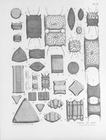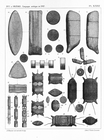| Introduction | | Species lists | | Search taxa | | Taxon tree | | Literature | | Distributions | | Statistics | | Editors | | Match taxa | | Webservice | | Log in |
WoRMS taxon detailsOdontella aurita (Lyngbye) C.Agardh, 1832
Biddulphia aurita (Lyngbye) Brébisson, 1838 · unaccepted (synonym)
marine,
recent only
Not documented
Distribution Probably cosmopolitan; most abundant in north temperate regions. Possibly a littoral species.
Distribution Probably cosmopolitan; most abundant in north temperate regions. Possibly a littoral species. [details]
Kociolek, J.P.; Blanco, S.; Coste, M.; Ector, L.; Liu, Y.; Karthick, B.; Kulikovskiy, M.; Lundholm, N.; Ludwig, T.; Potapova, M.; Rimet, F.; Sabbe, K.; Sala, S.; Sar, E.; Taylor, J.; Van de Vijver, B.; Wetzel, C.E.; Williams, D.M.; Witkowski, A.; Witkowski, J. (2024). DiatomBase. Odontella aurita (Lyngbye) C.Agardh, 1832. Accessed through: World Register of Marine Species at: https://www.marinespecies.org/aphia.php?p=taxdetails&id=149050 on 2024-11-16
context source (HKRMS)
Clark, A. M. (1982). Echinoderms of Hong Kong. <em>In: Morton B, editor. Proceedings of the first international marine biological workshop: The marine flora and fauna of Hong Kong and southern China. Hong Kong University Press, Hong Kong.</em> 1: 485-501. [details]
context source (Schelde) Maris, T.; Beauchard, O.; Van Damme, S.; Van den Bergh, E.; Wijnhoven, S.; Meire, P. (2013). Referentiematrices en Ecotoopoppervlaktes Annex bij de Evaluatiemethodiek Schelde-estuarium Studie naar “Ecotoopoppervlaktes en intactness index”. <em>Monitor Taskforce Publication Series, 2013-01. NIOZ: Yerseke.</em> 35 pp. (look up in IMIS) [details] basis of record Muylaert, K.; Sabbe, K. (1999). Spring phytoplankton assemblages in and around the maximum turbidity zone of the estuaries of the Elbe (Germany), the Schelde (Belgium/The Netherlands) and the Gironde (France). <i>J. Mar. Syst. 22</i>: 133-149 (look up in IMIS) [details] additional source Tomas, C.R. (Ed.). (1997). Identifying marine phytoplankton. Academic Press: San Diego, CA [etc.] (USA). ISBN 0-12-693018-X. XV, 858 pp., available online at http://www.sciencedirect.com/science/book/9780126930184 [details] additional source Horner, R. A. (2002). A taxonomic guide to some common marine phytoplankton. <em>Biopress Ltd. Bristol.</em> 1-195. [details] additional source Linkletter, L. E. (1977). A checklist of marine fauna and flora of the Bay of Fundy. <em>Huntsman Marine Laboratory, St. Andrews, N.B.</em> 68: p. [details] additional source Martin, J. L.; LeGresley, M. M. ; Strain, P. M. (2001). Phytoplankton monitoring in the Western Isles region of the Bay of Fundy during 1997-98. <em>Canadian Technical Report of Fisheries and Aquatic Sciences 2349.</em> 4: 1-85. [details] additional source Rawlence, D.L. 1987. A guide to common phytoplankton of the St. Croix Estuary, New Brunswick. The New Brunswick Museum Publications in Natural Science No. 6. 60 p. [details] additional source Thomas, M. L. H. (1983). Marine and coastal systems of the Quoddy Region, New Brunswick. <em>Canadian Special Publication of Fisheries and Aquatic Sciences.</em> 64:1-306. [details] Available for editors additional source Hällfors, G. (2004). Checklist of Baltic Sea Phytoplankton Species (including some heterotrophic protistan groups). <em>Baltic Sea Environment Proceedings.</em> No. 95: 210 pp., available online at http://helcom.fi/Lists/Publications/BSEP95.pdf [details] Available for editors additional source Scott, F.J.; Marchant, H.J. (Ed.). (2005). Antarctic marine protists. <em>Australian Biological Resources Study: Canberra.</em> ISBN 0-642-56835-9. 563 pp., available online at http://its-db.aad.gov.au/proms/pubn/pubshow.asp?pub_id=12140 [details] additional source Krayesky, D. M.; Meave, D. C.; Zamudio, E.; Norris, E.; Fredericq, S.; Tunnell, J. (2009). Diatoms (Bacillariophyta) of the Gulf of Mexico. <em>Gulf of Mexico origin, waters, and biota.</em> 1: 155-186. [details] Available for editors additional source Hasle, G. R.; Syvertsen, E. E. (1997). Marine Diatoms. pp. 5-385. In: C.R. Tomas (ed.) (1997). Identifying Marine Phytoplankton. Academic Press: San Diego, CA [etc.] (USA). ISBN 0-12-693018-X. XV, 858 pp., available online at http://www.sciencedirect.com/science/article/pii/B9780126930184500045 [details] additional source Hartley, B., Ross, R. & Williams, D.M. (1986). A check-list of the freshwater, brackish and marine diatoms of the British Isles and adjoining coastal waters. <em>Journal of the Marine Biological Association of the United Kingdom.</em> 66(3): 531-610. [details] Available for editors additional source Ferrario, M. E & Sastre, V. (1990). Ultraestructura, polimorfismo y ecología de Odontella aurita (Lyngbye) Agardh (Bacillariophyceae) en el estuario del río Chubut, Argentina. <em>Rev. Fac. de Ocean., Pesq. y Cs. Alimentarias 2: 98-106.</em> [details] Available for editors additional source Integrated Taxonomic Information System (ITIS). , available online at http://www.itis.gov [details]  Present Present  Present in aphia/obis/gbif/idigbio Present in aphia/obis/gbif/idigbio  Inaccurate Inaccurate  Introduced: alien Introduced: alien  Containing type locality Containing type locality
Unreviewed
Diet phytosynthetic [details]Distribution Probably cosmopolitan; most abundant in north temperate regions. Possibly a littoral species. [details] Habitat pelagic or attached to various marine life [details] Importance most abundant phylum of algae [details] Morphology yellow brown in color, not green [details] Predators marine microorganisms and animal larvae [details] Reproduction general for group: both sexual and asexual [details]
PlanktonNet Image
PlanktonNet Image (from synonym Biddulphia aurita (Lyngbye) Brébisson, 1838) To Barcode of Life To Biodiversity Heritage Library (193 publications) (from synonym Biddulphia aurita (Lyngbye) Brébisson, 1838) To Biodiversity Heritage Library (48 publications) To Dyntaxa To European Nucleotide Archive, ENA (Odontella aurita) To GenBank (63709 nucleotides; 25708 proteins) To PESI (from synonym Biddulphia aurita (Lyngbye) Brébisson, 1838) To PESI To Yale Peabody Museum of Natural History (YPM IZ 077056) To ITIS Unreviewed
|





